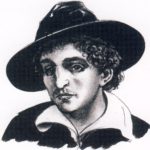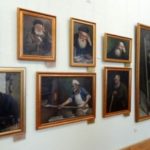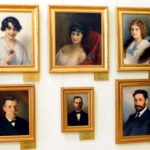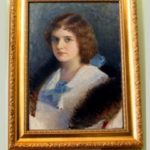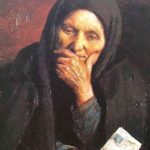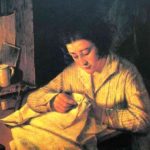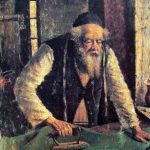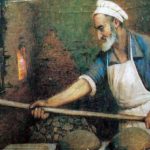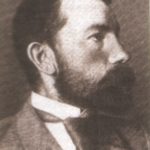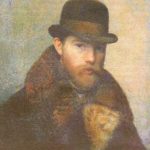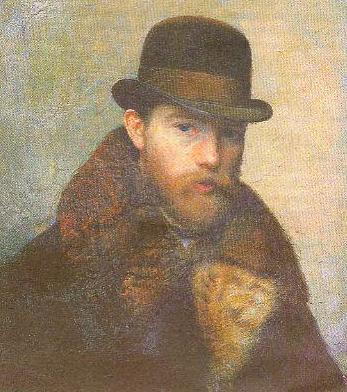
The Zarasai Regional History Museum is holding an exhibit called “Pen and His Students,” partially financed by the Lithuanian Cultural Council. The exhibit is on loan from the Vitebsk Regional History Museum and will run until October 13.
The exhibit features the life and work of Yehuda Pen, who was born and grew up in Zarasai (then known as Novoaleksandrovsk), Lithuania, and his world-famous students. It includes 22 works of art. Local residents and visitors have a wonderful opportunity to view the works of the local artist and his famous pupils, who include Isak Borovsky, Piotr Zankevich, Isak Zeldin, Yelena Kabishsher-Yakerson, Piotr Yavich and Mikhail Kuznetsov.
The exhibit will move on to Vilnius later for an exhibition at the Vilna Gaon State Jewish Museum.
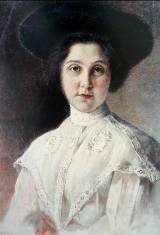
Portrait of a dame, Yehuda
Pen, oil on canvas, 1910
(64.5 х 45.0).
§ § §
Yehuda Pen (June 5,1854–March 2, 1937) was born in Zarasai, then located in the Novoaleksandrovske district of Kovna guberniya in the Russian Emprie, on June 5, 1854, to a poor Jewish family. Pen is well known as a Belarusian artist and teacher. He was Marc Chagall’s first teacher. His father passed away when he was only four. He enjoyed drawing caricatures and humorous things, and sometimes got in trouble for it. His mother sent him to the heder where his gift for drawing blossomed. He drew letters in books, colored Purim rattles and performed other artistic work for the local Jewish community. He most liked to draw portraits of locals, generals and Cossack horsemen. He moved to Daugavpils (or Dvinsk) in 1867 where he served an assistant to a house painter, and also did book illustrations, posters and shop signs. Once when he was visiting the home of the Pumpiansky family, where all city dwellers with an appreciation of art flocked, he met Borukh Girshovich, then a student on vacation from the art academy. He encouraged Pen to try his luck in Saint Petersburg. In the summer of 1879 Pen did go, and in 1880 matriculated as a student at the Academy. Surrounded by the highly anti-Semitic atmosphere of the time, Pen stuck together with other Jewish artists, including Ilya Ginzburg (1859-1939). The talented painter Pavel Chistyakov (1832-1919) was his teacher. Pen was graduated from the landscape painting class with a silver medal. He returned to Zarasai in 1886, looked for work in Daugavpils and finally settled for a time in Riga.
In Riga he met baron N. N. Korf, who offered him work in Kreisburg (Krāslava, Kreslawka), a village between Daugavpils and Vitebsk. The famous painter Ilya Repin had bought the Zdravnev manor near Vitebsk. He lived there from 1892 to 1896, except not in winter. Pen visited Zravnev as well. There they hatched the idea of looking for patrons to start an art school in Vitebsk. Pen moved back to Saint Petersburg after that and received permission to reside there. Then in November, 1897, Pen opened his School of Drawing and Painting in Vitebsk. Most of the students were Jewish. Pen’s pupils included Chagall, Salamon Yudovin, Ossip Zadkine, Lazar Lissitzky, Oskar Meshnikov, Abel Pann and others. After the school had earned a reputation for itself, Pen began around 1900 to invited famous figures such as Kazimir Malevich, Mstislav Douzhinsky, Ivan Puni, David Yakerson and many more to come to teach there. His school operated until 1918 when Chagall opened the Vitebsk Arts College. He invited his first teacher, Pen, to become a both a teacher and a prorector there.
Yehuda Pen created over 800 works, including drawings, sketches, studies and portraits. He was especially good at scenes from and portraits of the daily life of Jewish craftsmen, which he knew since childhood. Pen’s ideal was Rembrandt and he attempted to emulate his style. One of Pen’s most famous paintings is “Divorce” (1907). He also found a muse in Basia Aselrod from Pskov, whose portrait Pen particularly enjoyed painting.
Pen’s works were shown in Saint Petersburg (Petrograd) and he was part of the exhibitions held by the St. Petersburg Art Academy. Forty-two works by Pen were exhibited in Minsk in 1925. Pen organized an exhibition to mark the 50th anniversary of his creative career in 1933.
The artist stored all his work at home, a poor apartment whose walls were covered from floor to ceiling with paintings and drawings. He had wanted to donate his complete works to the city of Vitebsk, but appropriate housing for his creative output could never be found, and he wasn’t prepared to put his artwork just anywhere.
It’s an interesting fact that the artist never sold his work, he kept them all at home, because he didn’t want “to engage in commerce in my inspiration,” as he put it. Sadly, it is suspected the 83-year-old Pen was murdered at his home at night because for his rich collection of works. Relatives were later accused of trying to profit from his work. Pen is buried in the Staro-Semyonovsky Cemetery in Vitebsk.
A picture gallery was established for his works in Vitebsk following his death which displayed the works of over 80 artists from 1939 to 1941, but following the removal of the entire gallery to Saratov during the war, many of Pen’s works were lost, although several were preserved in the archives of the Museum of Art of the Byelorussian Soviet Socialist Republic.
Information prepared by Vasilijus Trusovas,
cultural events coordinator,
Zarasai Regional History Museum


